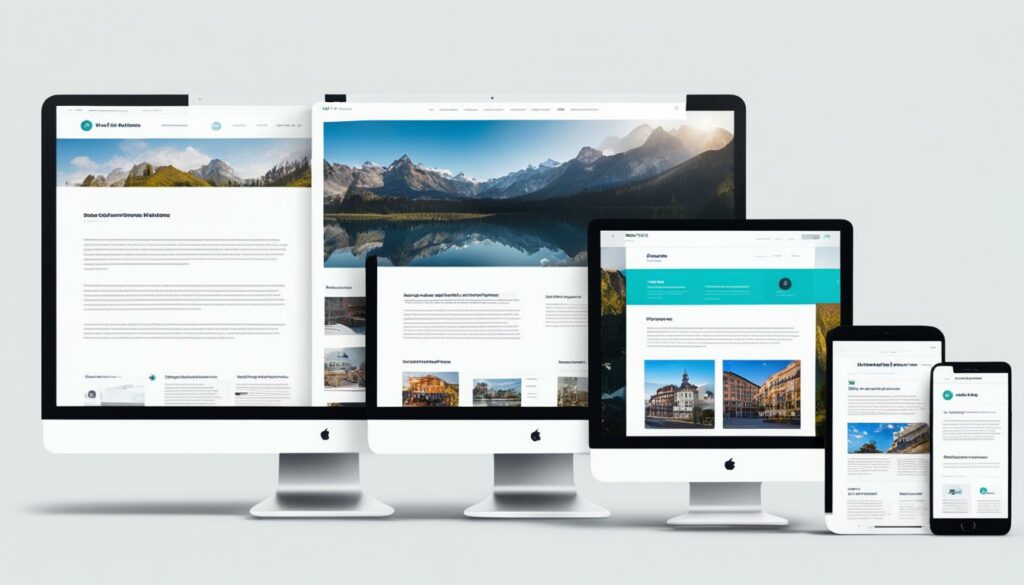Welcome to the complete overview of enhancing user experience on WordPress. As a leading content management system, WordPress offers endless opportunities for creating a user-friendly and accessible website. In this article, we will explore the importance of WordPress accessibility, website design, and compliance with WCAG and ADA guidelines, along with practical strategies to make your WordPress site more inclusive and user-centric.
Key Takeaways:
- Website accessibility is crucial for ensuring a positive user experience.
- Creating an inclusive web design with accessible WordPress themes is essential.
- Screen reader compatibility and keyboard navigation enhance usability for all users.
- Alt text for images improves accessibility for visually impaired visitors.
The Importance of Design in User Experience
Design plays a crucial role in enhancing the user experience on WordPress sites. It goes beyond aesthetics and focuses on creating a smooth and intuitive user experience. Key elements of design include:
- Visual appeal: A visually appealing website captures users’ attention and encourages them to explore further.
- Brand identity: Design should align with the brand’s identity and reflect its values and personality.
- User-centric layouts: Layouts should prioritize user needs, making it easy for them to navigate and find desired information.
- Consistency: Consistent design elements, such as fonts, colors, and imagery, create a cohesive experience across the site.
- Accessibility: Design should be accessible to all users, including those with disabilities, through features like alt text and screen reader compatibility.
- Interactivity: Engaging users through interactive elements, such as buttons, forms, and sliders, enhances the overall user experience.
- Loading times: Optimizing loading times is crucial to prevent user frustration and ensure a smooth browsing experience.
- Visual complexity: Striking a balance between visual appeal and simplicity is important to avoid overwhelming users with too many elements or distractions.
By prioritizing these design elements, you can create a visually appealing, user-centric, and accessible website that provides an exceptional browsing experience.
The Role of Navigation in User Experience
Navigation is a critical aspect of the user experience on any website. It serves as a guide for visitors, helping them find the information or products they need quickly and easily. When it comes to WooCommerce sites, effective navigation becomes even more important, as users are looking to explore and purchase products.
To create a seamless user experience, it is essential to have a user-friendly menu that is clear and concise. A cluttered or confusing menu can lead to frustration and abandonment. By organizing your WooCommerce products into logical categories, users can navigate through your offerings effortlessly.
Implementing search functionality is another valuable addition to your navigation. It allows users to directly search for specific products, saving them time and effort. This search functionality should be prominently displayed and easy to use, ensuring users can find what they are looking for with just a few keystrokes.
Providing easy access to product categories is also key. By categorizing your products and including clearly labeled dropdown menus or sidebars, users can easily browse through different product options and explore the full range of what your WooCommerce site has to offer.
Example of a User-Friendly Menu for a WooCommerce Site:
| Product Category | Subcategories |
|---|---|
| Electronics |
|
| Clothing |
|
| Home Decor |
|
By implementing a user-friendly menu, effective search functionality, and easy access to product categories, you can ensure that your WooCommerce site provides a seamless and enjoyable navigation experience for your visitors.
The Impact of Performance on User Experience
When it comes to your website, performance plays a crucial role in ensuring a seamless user experience. Slow loading times, sluggish response, and security vulnerabilities can significantly impact user satisfaction and engagement. It is essential to optimize your website’s performance to deliver a fast, secure, and responsive experience for your visitors.
There are various optimization strategies you can implement to improve website performance:
- Caching: Implementing a caching mechanism can significantly reduce load times by storing frequently accessed data, such as HTML pages, in a temporary storage location. This way, instead of generating the page from scratch every time a user requests it, the cached version is served, resulting in faster loading times.
- Image compression: Images are often a significant contributor to slow loading times. By compressing images without compromising quality, you can reduce their file sizes, resulting in faster load times and improved user experience. Use tools like
tinypng.comto compress your images before uploading them to your WordPress site. - Minimizing code: Overly complex and bloated code can slow down your website. Minifying your CSS and JavaScript files by removing unnecessary characters, comments, and spaces can help reduce file sizes and improve loading times. Using tools like WP Rocket or Autoptimize can automate this process.
- User data protection: Protecting user data is vital for building trust and maintaining a positive user experience. Implement measures such as two-factor authentication, secure passwords, and regular security updates to safeguard user information from potential threats.
- Software updates: Keeping your WordPress core, themes, and plugins updated ensures that you have access to the latest features, bug fixes, and security patches. Regular updates help maintain optimal website performance and protect against potential vulnerabilities.
- SSL certificates: Implementing an SSL certificate is essential for securing your website and encrypting sensitive data transmitted between your visitors’ browsers and your server. It not only improves security but also enhances trust and credibility.
- Secure hosting: Choosing a reliable and secure hosting provider is crucial for ensuring optimal website performance. Look for hosts that offer features such as strong firewalls, regular backups, intrusion detection systems, and advanced server configurations to protect your site from attacks and provide a secure hosting environment.
By implementing these performance optimization strategies and prioritizing user data protection, you can significantly improve the overall user experience on your WordPress site.
The Benefits of Improving User Experience
Enhancing the user experience on your WordPress site can have a significant impact on your online business. By prioritizing user experience, you can reap a myriad of benefits that ultimately contribute to your success.
Improved Conversions
When users have a positive experience on your website, they are more likely to take action and convert. By providing a seamless and enjoyable browsing experience, you can increase conversion rates and ultimately drive more sales.
Setting a Good First Impression
Your website is often the first point of contact with potential customers. By delivering a smooth and user-friendly experience from the moment they land on your site, you can set a good first impression and establish trust and credibility with your audience.
Increased Sales
A positive user experience can directly impact your sales figures. When users find it easy to navigate your site, locate products or services, and complete their purchases effortlessly, they are more likely to make repeat purchases and recommend your brand to others, leading to increased sales.
User Retention Rates
By prioritizing user experience, you can improve user retention rates. When visitors enjoy their time on your site, find value in your content, and have a seamless browsing experience, they are more likely to return in the future and become loyal customers.
Improved SEO
Search engines value user experience, and it plays a significant role in determining your website’s ranking. When your site offers a smooth and engaging experience, search engines are more likely to rank it higher, resulting in increased visibility, organic traffic, and improved SEO performance.

Improving user experience on your WordPress site is an investment that yields numerous benefits. By focusing on creating a seamless and enjoyable browsing experience, you can enhance conversions, set a good first impression, increase sales, improve user retention rates, and boost your SEO rankings.
Strategies to Improve User Experience on WordPress
Enhancing the user experience on your WordPress site is crucial for attracting and engaging visitors. By implementing the following strategies, you can create a seamless and enjoyable experience for your users.
1. Simple Design with Easy Navigation
A simple and clean design allows users to focus on your content without distractions. Use a minimalistic layout, choose a user-friendly color scheme, and ensure that your website’s navigation is clear and intuitive. Additionally, make sure that your menus are limited and organize your content in a logical manner.
2. Informative and Engaging Homepage
Your homepage serves as a digital storefront, making it essential to capture visitors’ attention right away. Provide a brief overview of your site’s purpose and content, and use eye-catching elements like images or videos to make it visually appealing. Consider including a call-to-action to encourage users to explore further.
3. Readable Content for Better Understanding
High-quality and readable content is crucial for keeping users engaged. Keep paragraphs short, use headings and subheadings to structure your content, and break up large blocks of text with bullet points or numbered lists. Choose a legible font size and style to ensure easy reading.
4. Incorporate Eye-Catching Elements
Adding visually appealing elements like infographics, charts, or shareable quotes can make your content more engaging and memorable. These elements help break up the text and make it easier for users to digest information. Just make sure they are relevant and add value to your content.
5. Effective Use of Call-to-Actions
Strategically place call-to-actions throughout your website to guide users towards desired actions. Whether it’s signing up for a newsletter, making a purchase, or contacting you, clear and compelling call-to-actions can significantly boost user engagement and conversions.
6. Optimize for Mobile Experience
Given the prevalence of mobile usage, it’s crucial to optimize your WordPress site for mobile devices. Choose a responsive theme that adapts to different screen sizes, ensure that buttons and links are easily tappable, and optimize page loading speed for a smooth mobile experience.
7. Collect and Act on Visitor Feedback
Regularly collect feedback from your website visitors to gain insights into their experience and identify areas for improvement. Add a feedback form or survey to your site, ask for reviews or ratings, and actively listen to user suggestions. Use the feedback to continuously enhance your site’s user experience.
| Strategy | Description |
|---|---|
| Simple Design with Easy Navigation | Create a clean and user-friendly design with clear navigation menus to enhance user experience. |
| Informative and Engaging Homepage | Make your homepage visually appealing and provide relevant information to captivate visitors. |
| Readable Content for Better Understanding | Break up text with headings, subheadings, and bullet points to improve readability and comprehension. |
| Incorporate Eye-Catching Elements | Use visual elements like infographics and charts to make your content more engaging and memorable. |
| Effective Use of Call-to-Actions | Add clear and compelling call-to-actions to guide users towards desired actions on your website. |
| Optimize for Mobile Experience | Ensure your WordPress site is fully optimized for a seamless mobile browsing experience. |
| Collect and Act on Visitor Feedback | Regularly gather feedback from visitors to make informed improvements and enhance user experience. |
By implementing these strategies, you can significantly improve the user experience on your WordPress site, leading to increased engagement, higher conversion rates, and a growing base of satisfied visitors.
The Power of a Simple Design and Easy Navigation
A simple design with easy navigation is key to a positive user experience on your WordPress site. By implementing limited menus, minimal sidebars, and helpful navigation elements, you can ensure that visitors can easily find the information they need and navigate through your site effortlessly.
One of the first steps in creating a simple design is to limit the number of menus on your site. Having too many menus can overwhelm users and make it difficult for them to find what they are looking for. By keeping your menus concise and focused, you can simplify the navigation experience and guide users to the most important sections of your site.
| Key Points: |
|---|
| • Limited menus |
| • Minimal sidebars |
| • Helpful navigation elements |
| • Warm colors |
| • Trustworthy theme and plugins |
Alongside limited menus, it’s also beneficial to have minimal sidebars on your site. Sidebars can easily distract users and clutter the overall design. By keeping sidebars to a minimum, you can maintain a clean and uncluttered layout that enhances user focus and reduces any potential distractions.
When it comes to navigation elements, it’s important to provide clear and intuitive options for users to navigate your site. This includes a well-designed main menu, breadcrumbs for easy navigation back to previous pages, and a search bar for quick access to specific content. These elements help users easily find their way around your site, improving their overall experience.
Additionally, choosing warm colors that match your site’s color scheme can create a welcoming and pleasant atmosphere for users. Warm colors are known to evoke positive emotions and can make your site more inviting and engaging.
Lastly, using trustworthy themes and plugins is crucial for ensuring the stability and security of your site. By selecting reputable and reliable themes and plugins, you can mitigate the risk of compatibility issues, security vulnerabilities, and performance issues that could negatively impact the user experience.
Benefits of a Simple Design and Easy Navigation:
- Improved user experience: Limited menus and minimal sidebars reduce distractions and help users focus on the main content.
- Easier navigation: With helpful navigation elements, users can find what they need quickly and effortlessly.
- Enhanced visual appeal: Warm colors create a visually pleasing and inviting atmosphere for users.
- Increased trust: Using trustworthy themes and plugins instills confidence in users, making them more likely to engage with your site.
By incorporating a simple design with easy navigation, your WordPress site can provide visitors with a seamless and enjoyable experience. From limited menus to trustworthy themes and plugins, every element of your design should aim to enhance usability and create a positive impression.
The Importance of Fast Loading Pages
Fast loading pages are essential for providing a seamless user experience on your WordPress site. When visitors click on your website, they expect it to load quickly without any delays. Slow-loading pages can lead to frustration, increased bounce rates, and a negative impression of your brand. To ensure that your website loads at lightning speed, there are several strategies you can implement:
- Multimedia Compression: Compress images, videos, and other multimedia elements to reduce their file size without compromising quality. This significantly improves page loading speed.
- Fast-loading WordPress Themes: Choose themes that are optimized for speed and performance. These themes are designed to minimize code and prioritize fast loading times.
- Minimizing Redirects: Reduce the number of redirects on your website as they can slow down page load times. Redirects should only be used when necessary.
- Optimizing Server Response Time: Ensure that your web hosting server responds quickly to requests from visitors. Choose a reliable hosting provider that offers fast and stable servers.
- Eliminating Unnecessary JavaScript and CSS Files: Remove any unused or unnecessary JavaScript and CSS files from your website. These files can contribute to longer loading times.
- Caching: Implement caching techniques to store and deliver static versions of your web pages to visitors. This reduces the need for repetitive processing and speeds up loading times.
By implementing these strategies, you can significantly improve the loading speed of your WordPress site, enhancing the user experience and ensuring that visitors stay engaged and satisfied.
Real-life Example: The Impact of Page Loading Speed
“When we optimized our website’s loading speed, we saw a noticeable improvement in user engagement. Our bounce rates decreased, and visitors spent more time exploring our content. This led to increased conversions and a positive impact on our bottom line. Fast loading pages have become a top priority for our website, and we continue to implement strategies to ensure that our visitors have a seamless browsing experience.”
– Ashley Thompson, CEO of FastTech Solutions
Enhancing Readability for Better User Experience
Readability plays a significant role in improving the user experience on a WordPress site. When it comes to creating quality content that is easy to read and understand, there are several key factors to consider. By implementing these strategies, you can reduce the bounce rate and ensure that your visitors stay engaged with your website. Here are some effective techniques to enhance readability:
Catchy Headlines
Crafting catchy headlines is essential for grabbing your readers’ attention and enticing them to explore further. A compelling headline can pique their curiosity and compel them to read the entire article or webpage.
Bullet Points
Using bullet points makes your content scannable and digestible. It allows readers to quickly grasp the main points and key information without feeling overwhelmed by long paragraphs.
Readable Fonts
Choosing readable fonts is crucial for ensuring that your content is accessible to all users. Opt for fonts that are easy on the eyes and provide a pleasant reading experience, even on smaller screens.
Paragraph Breaks
Breaking your content into paragraphs helps to improve readability by providing visual breaks and creating a logical flow. It allows readers to navigate through your content effortlessly.
Headings
Using proper heading hierarchy not only helps with SEO but also enhances the readability of your content. Clear and descriptive headings make it easier for readers to scan through the page and find the information they need.
“Good typography is invisible. Bad typography is everywhere.”
– Boagworld

| Techniques | Benefits |
|---|---|
| Use catchy headlines | Grab reader’s attention, increase engagement |
| Utilize bullet points | Improve scannability, aid readability |
| Choose readable fonts | Enhance accessibility, pleasant reading experience |
| Break content into paragraphs | Provide visual breaks, create flow |
| Use proper heading hierarchy | Improve scanning and navigation |
By implementing these strategies, you can enhance the readability of your WordPress site and provide a better user experience. Remember, quality content that is easy to read and understand not only keeps visitors on your site longer but also encourages them to take the desired actions, leading to increased conversions and overall success.
Utilizing Eye-Catching Elements
Eye-catching elements like infographics, charts and figures, and shareable quotes can significantly enhance the visual appeal of your content and engage your users. These elements provide variety, color, and an interactive experience that makes your content more visually appealing and memorable.
“An infographic can communicate complex information in a visually appealing and easy-to-understand format, making it highly shareable and engaging.”
Infographics are a great way to convey complex information in a visually appealing and easy-to-understand format. They utilize visual elements, such as charts, graphs, and images, to present data and statistics in a way that is more digestible for your audience. Infographics can be used to showcase step-by-step processes, compare different options, or highlight key points in a visually compelling manner.
Charts and figures are another effective way to present data and statistics. Whether it’s a line graph, bar chart, or pie chart, visualizing data can make it easier for your audience to understand and interpret the information you’re conveying. Charts and figures can be used to showcase trends, compare different variables, or present data in a visually appealing manner.
“A shareable quote can be a powerful tool to evoke emotion, inspire action, and encourage social sharing.”
Shareable quotes are short, impactful statements that can evoke emotion, inspire action, and encourage social sharing. By highlighting key insights or capturing thought-provoking ideas within your content, you provide users with snippets that can be easily shared on social media platforms. Shareable quotes can be visually emphasized within your content to grab attention and encourage users to share them with their followers.
By incorporating infographics, charts and figures, and shareable quotes into your content, you can enhance its visual appeal, engage your users, and make a lasting impression. These eye-catching elements not only make your content more visually appealing but also help in conveying information effectively and promoting social sharing.
The Power of Call-to-Actions
Including call-to-actions on your WordPress site is a powerful strategy to boost user engagement and drive conversions. By strategically placing call-to-actions throughout your site, such as using popups, forms, and chat options, you can guide visitors towards taking desired actions and enhance their overall user experience.
Call-to-actions serve as prompts that influence users to take specific actions, such as making a purchase, signing up for a newsletter, or contacting your business. They effectively grab users’ attention and encourage them to interact with your site, increasing the likelihood of conversions.
Popups are one popular form of call-to-action that can be effective in capturing users’ attention. Whether it’s a special offer, an invitation to sign up for a webinar, or a newsletter subscription prompt, popups can provide valuable information and encourage users to take the next step.
Forms are another valuable call-to-action tool that can be easily integrated into your WordPress site. By creating well-designed and user-friendly forms, you can prompt visitors to provide information, request a quote, or submit feedback, allowing you to engage with your audience and potentially convert them into customers.
In addition to popups and forms, consider implementing chat options on your site. Chatbots and live chat features can enhance the user experience by providing real-time assistance and support. Users can ask questions, seek clarification, or get recommendations, helping them make informed decisions and increasing their trust in your brand.
Benefits of Call-to-Actions
Integrating call-to-actions into your WordPress site offers several benefits:
- Increased User Engagement: Call-to-actions encourage users to interact with your site, boosting overall engagement and prolonging their time on your site.
- Higher Conversion Rates: By guiding users towards specific actions, call-to-actions improve conversion rates and drive the desired outcomes, such as product purchases or lead generation.
- Improved User Experience: Call-to-actions provide clear directions and make it easier for users to navigate your site, resulting in a smoother and more enjoyable experience.
- Personalized Interactions: Forms and chat options allow for personalized interactions, giving users a sense of individual attention and increasing their satisfaction with your brand.
“Including call-to-actions, such as popups, forms, and chat options, can improve user engagement and conversion rates.”
To make the most of call-to-actions, ensure they are strategically placed and aligned with your site’s goals. Consider the user journey and the different stages of the conversion funnel when deciding where to position your call-to-actions. A well-placed and compelling call-to-action can make a significant difference in encouraging users to take the desired action.

Conclusion
Improving the user experience on a WordPress site is vital for creating a positive impression, increasing conversions, enhancing user retention, improving SEO rankings, and maximizing business revenue. By implementing strategies like simple design, easy navigation, fast loading pages, quality content, eye-catching elements, call-to-actions, optimizing the mobile experience, and collecting visitor feedback, you can significantly enhance the user experience and achieve your business goals.
A simple design with clear and intuitive navigation allows users to easily find what they need on your WordPress site. Fast loading pages ensure a smooth browsing experience, while high-quality content keeps users engaged. Eye-catching elements like infographics and engaging call-to-actions encourage user interaction and improve conversions. Optimizing your site for mobile devices is essential in today’s mobile-driven world.
Lastly, collecting visitor feedback is crucial for understanding user preferences and pain points, allowing you to make continuous improvements and provide an even better user experience. By focusing on these key strategies, you can create a website that not only impresses your visitors but also drives business growth and success.
FAQ
Q: What is the role of design in enhancing user experience on WordPress sites?
A: Design is not just about aesthetics, but also about creating a smooth and intuitive user experience. It involves visual appeal, aligning with brand identity, user-centric layouts, consistency, accessibility, interactivity, and optimizing loading times and visual complexity.
Q: How does navigation impact the user experience on a WordPress site?
A: Navigation is crucial for guiding visitors and helping them find what they need. For WooCommerce sites, organizing products in a user-friendly manner is key. This involves creating a clear and concise user-friendly menu, implementing effective search functionality, and providing easy access to product categories.
Q: What role does performance play in user experience on WordPress sites?
A: Performance is crucial for a seamless user experience. Optimization strategies, such as caching and image compression, can significantly improve loading times. Regular software updates and the use of SSL certificates enhance website security and protect user data. Choosing a secure hosting provider is also crucial for maintaining a secure WordPress site.
Q: What are the benefits of improving user experience on a WordPress site?
A: Improving user experience can lead to increased conversions, set a good first impression of the brand, boost sales, improve user retention rates, and positively impact SEO rankings.
Q: What are some strategies to enhance user experience on WordPress sites?
A: Strategies include using a simple design with easy navigation, creating an informative and engaging homepage, ensuring readable content, incorporating eye-catching elements like infographics, using call-to-actions, optimizing the mobile experience, and collecting visitor feedback for continuous improvement.
Q: How does a simple design and easy navigation contribute to user experience?
A: A simple design with easy navigation is key to a positive user experience. This involves having limited menus, minimal sidebars, and helpful navigation elements. Choosing warm colors that match the site’s color scheme and using trustworthy themes and plugins further enhance the user experience.
Q: What is the importance of fast loading pages for user experience?
A: Fast loading pages are crucial for a seamless user experience. Optimization strategies like multimedia compression, using fast-loading WordPress themes, minimizing redirects, optimizing server response time, eliminating unnecessary JavaScript and CSS files, and using caching techniques can significantly improve loading times.
Q: How can readability be enhanced for a better user experience?
A: Readability plays a significant role in improving the user experience. It is important to create quality content that is easy to read and understand. This can be achieved by using catchy headlines, bullet points, readable fonts, breaking content into paragraphs, and using proper heading hierarchy.
Q: How can eye-catching elements enhance the user experience on a WordPress site?
A: Eye-catching elements like infographics, charts and figures, and shareable quotes can enhance the visual appeal of the content and engage users. These elements provide variety and color, making the content more visually appealing and memorable.
Q: How do call-to-actions contribute to a better user experience?
A: Including call-to-actions, such as popups, forms, and chat options, can improve user engagement and conversion rates. These features allow users to interact with the site and take desired actions, leading to a better user experience and increased conversions.











